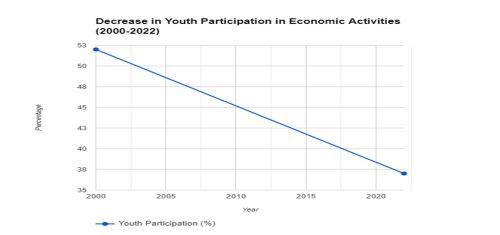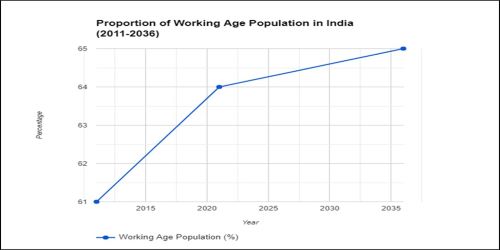Context-
The issue of unemployment among the youth in India has reached critical levels, exacerbated by factors such as contractual appointments and a growing reliance on consultancies. The India Employment Report 2024, jointly prepared by the Institute of Human Development (IHD) and the International Labour Organization (ILO), sheds light on the intricate dynamics of the labor market, particularly focusing on youth employment, education, and skills. The report look into two decades of labor market trends, including the tumultuous years of the COVID-19 pandemic, highlighting emerging challenges and the impact of economic growth on employment.
|
What is Unemployment? Unemployment is the state wherein an individual actively seeking employment cannot secure a job. It serves as a gauge of economic well-being, with the primary metric being the unemployment rate, calculated by dividing the number of unemployed individuals by the total labor force. National Sample Survey Organization (NSSO) defines employment and unemployment on the following activity statuses of an individual: ● Working (engaged in economic activity) i.e. 'Employed'. ● Seeking or available for work i.e. 'Unemployed'. ● Neither seeking nor available for work. Unemployment rate = (Unemployed Workers / Total labour force) × 100 |
Emerging Trends in Youth Unemployment
The report reveals a concerning trend where the proportion of India's working-age population has steadily increased, reaching 64% in 2021 and projected to climb to 65% by 2036. Despite this demographic surge, the percentage of youth engaged in economic activities has plummeted from 52% to 37% over the same period, signifying a disconnect between population growth and employment opportunities. Notably, the unemployment crisis predominantly affects the youth, particularly those with secondary education or higher qualifications, intensifying over time.

Moreover, the report highlights a significant increase in the share of unemployed youth within the total unemployed population, rising from 54.2% in 2000 to 65.7% in 2022. Disturbingly, educated youth, especially women, bear the brunt of unemployment, with women accounting for a larger share among educated unemployed youth. These trends underscore a multifaceted crisis, stemming from both a lack of job opportunities and the unemployability of educated youth due to deficiencies in the quality of education.
Challenges in Skill Development and Job Creation
The crisis in youth unemployment is further compounded by inadequacies in skill development and the quality of employment opportunities. The report emphasizes the need to separate skill development from formal education, advocating for a comprehensive approach to bridge the gap between education and employability. However, the report underscores a glaring disparity, with a mere 15.62% of youth having received vocational training in 2022, and only 4.09% of them undergoing formal vocational training.
Furthermore, the dominance of low-productive and low-earning jobs in both the informal and formal sectors perpetuates the cycle of unemployment and underemployment. Real wages and earnings have either declined or stagnated, exacerbating economic hardships for the labor force. With most jobs concentrated in the informal sector, there is an urgent need to create more formal employment opportunities to address the escalating unemployment crisis among the youth.
Gender Disparities in Labor Force Participation
The report sheds light on the persistent gender gap in the labor market, particularly concerning the low rates of female labor force participation. Despite modest improvements in recent years, the gender gap in the labor force participation rate remains substantial, with young men outnumbering young women by nearly threefold. Rural-urban disparities further exacerbate this divide, highlighting the need for targeted interventions to enhance female participation in the workforce.
Moreover, the report underscores a concerning trend of young women's engagement in agriculture, often indicative of limited opportunities in other sectors. Between 2012 and 2019, a decline in women's participation in the workforce contributed to a surge in unemployment, necessitating proactive measures to reverse this trend. Addressing gender disparities in labor force participation requires comprehensive strategies that promote inclusive economic growth and provide women with equal access to education, training, and employment opportunities.
|
Government initiatives to address unemployment: ● Integrated Rural Development Programme (IRDP) - Launched in 1980 to generate full employment opportunities in rural areas. ● Training of Rural Youth for Self-Employment (TRYSEM) - Started in 1979 to equip unemployed rural youth aged 18 to 35 with skills for self-employment, prioritizing SC/ST youth and women. ● RSETI/RUDSETI - Established in 1982 to tackle youth unemployment through joint efforts of educational trusts and banks, providing rural self-employment training. ● Jawahar Rozgar Yojana (JRY) - Commenced in April 1989 by merging NREP and RLEGP, sharing costs between the center and states. ● Mahatma Gandhi National Rural Employment Guarantee Act (MNREGA) - Implemented in 2005, guaranteeing 100 days of paid work per year to households opting for unskilled labor-intensive work. ● Pradhan Mantri Kaushal Vikas Yojana (PMKVY) - Launched in 2015 to offer industry-relevant skill training to Indian youth for better livelihood opportunities. ● Start-Up India Scheme - Introduced in 2016 to foster entrepreneurship nationwide. ● Stand Up India Scheme - Launched in 2016 to facilitate bank loans for SC/ST and women entrepreneurs, promoting greenfield enterprises. |
Policy Recommendations for Addressing Employment Challenges
In light of the daunting challenges outlined in the report, policymakers are urged to adopt a multi-faceted approach to tackle youth unemployment and labor market inequalities. The report proposes five key missions aimed at promoting employment-intensive growth, improving job quality, overcoming labor market disparities, enhancing skills training, and bridging knowledge gaps in labor market dynamics.
Specifically, the report calls for integrated policies that prioritize non-farm employment, support micro, small, and medium-sized enterprises (MSMEs), and decentralize decision-making processes. Additionally, there is a pressing need to enhance agriculture productivity, create more non-farm job opportunities, and foster entrepreneurship to diversify the economy and absorb the burgeoning youth population into gainful employment.
Conclusion
The India Employment Report 2024 serves as a wake-up call, highlighting the urgent need for concerted action to address the escalating youth unemployment crisis and labor market inequalities. With the demographic dividend at risk of turning into a demographic liability, policymakers must prioritize initiatives that promote inclusive economic growth, enhance skill development, and ensure equitable access to employment opportunities.
By implementing the recommended policy interventions and fostering collaboration between government agencies, civil society organizations, and the private sector, India can unlock the potential of its youth population and harness their talent to drive sustainable development and prosperity. However, achieving these goals will require sustained commitment, innovative strategies, and proactive measures to create an enabling environment for youth empowerment and economic advancement.
|
Probable Questions for UPSC Mains Exam
|
Source – The Hindu







